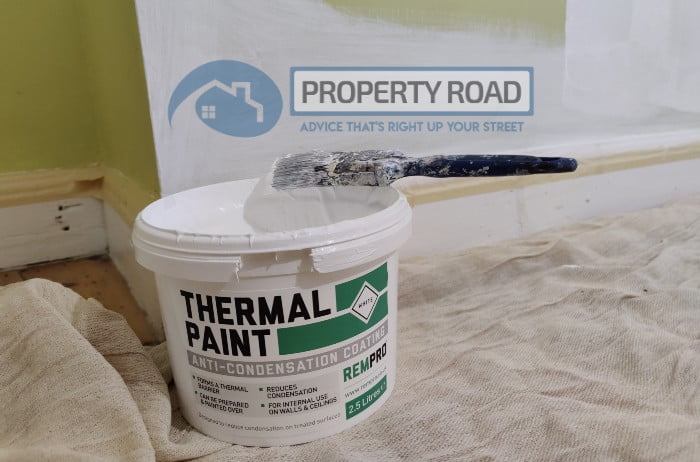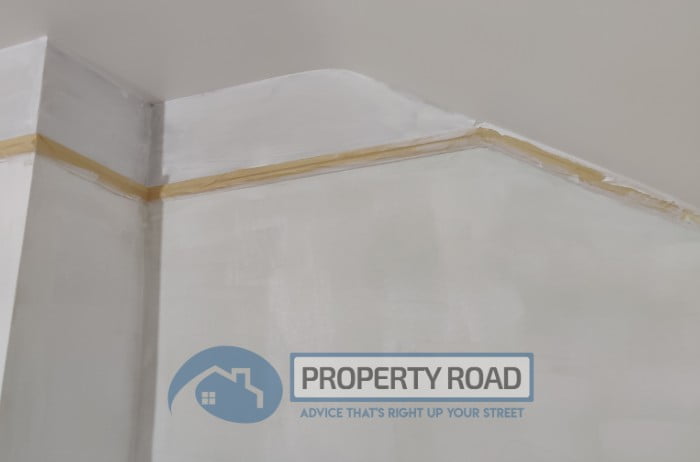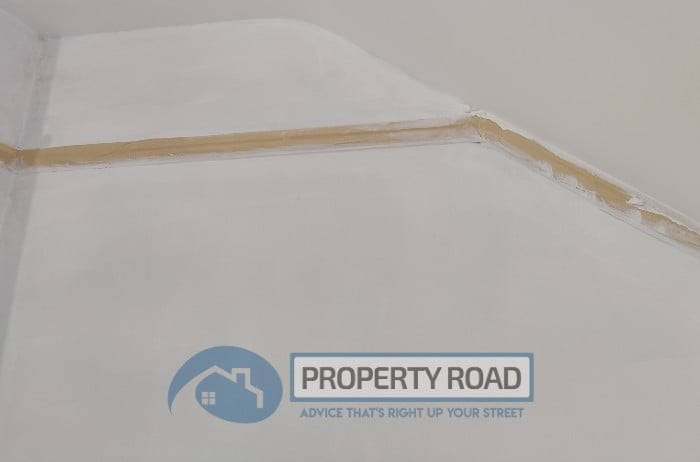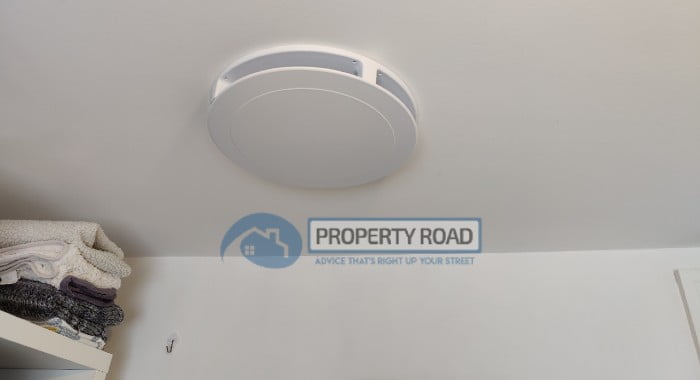Many people will know the frustration that comes with condensation problems at home. This not only has an impact on the aesthetic appeal of your property, but it can also pose health risks.
We have first-hand experience of the problems condensation can cause, having lived in an old solid brick wall property for several years (you can read our story, below).
Condensation happens when the interiors of buildings get really cold and water droplets form. This happens because of how warm the air is and how much moisture it holds (Galvin, 2010).
In addition to leaving unsightly marks and stains on walls and ceilings, condensation can lead to mould and mildew. This can then have a negative impact on health, particularly if there are vulnerable people such as those with respiratory issues in your household.
The best anti condensation paint can help to reduce this problem, and in this article, we will look at some of the top options and talk about our own experience with ant-condensation paint.
Our Top 5 Picks For The Best Anti Condensation Paint:
We’ve Featured In:



If you want to find the best anti condensation paint for your home, our top picks can help you to find the right one. While there are plenty of options available, some are better than others. In this article, you can learn about some of the best anti condensation paint options for your home.
#1: Rempro Thermal Paint

Check current stock levels, price, and reviews on Amazon
Features:
- Thermal paint with insulating properties
- Anti mould formula
- Anti-condensation paint
- Uses Glass Bubble Technology
- Gives a textured finish
- Excellent reviews
- Available in various quantities
- Maintains surface temperatures
- Proven formula
- 57 percent longer for condensation to form
- Ideal for a range of surfaces
What to Consider:
- Make sure you order the right size based on the area being treated
- Covers 4.5m2 per litre
- Make sure you read preparation guidelines for surfaces
- Carefully check instructions for use
- Two coats required
- Our top pick for the best anti condensation paint
Wondering if anti-condensation paint is the best option for you? Paul James, the founder of Property Road, talks you through his experience with condensation and Rempro Thermal Paint below…
Our Experience With Rempro Thermal Paint
We bought our current home in 2021. It’s a very rural old 1850’s detached property that’s partly solid brick walls and partly a newer cavity wall extension.
The layout of the property means the living room and bedroom both have 3 external solid brick walls with no insulation.
Naturally, this means these are the two coldest rooms in the house and in deep winter, the walls are almost painfully cold to the touch.
Condensation can lead to other problems and one of those is damp. A study focused on predicting relative the humidity in UK dwellings found that around 1.5 million homes in the UK are affected by dampness issues (Flannigan et al., 1991, as cited in Pretlove, 2000).
An informative article by Sample (2023) in The Guardian also reveals that damp invites the formation of moulds among other germs that can pose danger to the inhabitants of the house. It also reiterates that moulds are a huge threat to the respiratory system of the people inhaling it.
Compounding our condensation problems is the fact the rendering on our property isn’t breathable, so we have high internal humidity levels, anyway. Of course, this has created a perfect storm for condensation and mould to form.
The lower corners of the rooms are where the condensation and mould patches are the worst and it was starting to become quite the health hazard.

Lots of research led us to one product…
We looked into all sorts of different ways to resolve the problem, but adding wall insulation and re-rendering the house (the best option) is prohibitively expensive.
So, when we saw the opportunity to try anti-condensation paint, we were very much intrigued as it’s a cheap and easy solution… if it works!
Naturally, we did a lot of research, and the paint that consistently came out on top was Rempro Thermal Paint. There are no end of reviews stating how it made people’s walls warmer to the touch.
We have to admit though, we were very skeptical. Can a simple paint really have that much impact?
Well, there’s only one way to find out! As we wanted to redecorate anyway, we decided to try the paint in the bedroom first. In fact, we decided only to put it on the very end wall and the ends of the two side walls (after cleaning off the existing mould) so we had the coldest corners covered.

Truthfully, we were hesitant to spend too much on trying the paint as we didn’t expect it to work. Plus, we figured by only partially covering our external walls, we should more easily be able to feel the difference between the treated areas and the untreated areas.
The paint arrives…
We ordered from Amazon and were impressed with how well packaged the paint was. The lid was securely taped on and then the whole tub of paint was wrapped in sealed plastic to ensure no accidents during transit.
We had around 11m2 to cover so we bought a 2.5L tub since it says it covers 4-5m2 per litre. We found this estimate to be pretty much bang on as we still had a small amount of paint left at the end.
On opening the paint, we were quite surprised at the consistency. It’s like whipped cream and it looked almost good enough to eat (please don’t!)!

We used a No products found. as the tub suggests and a brush to cut in around the edges and we have to say, it applies really well.
We thought the consistency would mean it’s really hard work, but it was no more difficult to apply than standard emulsion and the coverage was really good.
After one coat, the wall looked quite patchy as they often do, but we weren’t concerned as we planned on doing two coats (as recommended by the manufacturers) anyway. Plus, we intended on painting over the top, the Rempro Thermal paint was essentially just a fancy, anti-condensation undercoat.

After the second coat, most of the patchiness was gone and the wall was ready for the colour coats.

It is worth pointing out that the texture of the paint once on the wall isn’t perfectly smooth. There’s a slightly rough textured feel to it – however, it’s hardly noticeable and certainly doesn’t spoil the finish at all.
The final verdict…
So, our experience of Rempro Thermal Paint so far had been excellent. So good, in fact, there haven’t really been any negatives to speak of.
But what about the big question, does it really make the wall feel warmer?
Surprisingly, the answer for us was a big fat YES! It was actually far more noticeable than we imagined.
It’s too early for us to say whether this will lead to a reduction in our condensation issues, however, we are extremely optimistic it will. After all, condensation forms on cold surfaces. The colder they are, the faster the condensation will appear (hence why the lower corners of our room were the worst effected).
Where condensation forms, mould follows. So, by keeping our walls warmer to the touch, we are reducing the chances of condensation forming and therefore also stopping the mould spots.
As an added layer of protection, we painted over the Rempro Thermal Paint with Dulux bathroom paint which includes anti-mould growth properties. Together, they should make an unbeatable combination!

Our biggest regret…
Our only real regret was not having more confidence in the product and painting all three external walls of the bedroom with the Rempro paint. However, now we know it does exactly what it says on the tin, we’ll be painting the external walls in all our rooms with it.
So, for us, we definitely found that anti-condensation paint is far from a gimmick. In fact, we were completely won-over by the impact it has had on the wall temperature.
Of course, if you’re still skeptical (like we were!) you can always buy a small amount and test it on an area of the wall first. Just don’t say I didn’t warn you when you realise it’s so effective you’ll have to order more!
Of course, Rempro Thermal Paint might be our pick for the best anti-condensation paint, based our personal experience of the product, but there are other options available too…
#2: Ronseal Anti Condensation Paint

Check current stock levels, price, and reviews on Amazon
Features:
- Matte white paint
- Excellent ratings
- Watercolour paint type
- Trusted brand
- Tough finish
- Can be scrubbed when dry
- Reduce the risk of mould
- Touch dry in an hour or two
- Insulating formula
- Can be painted over after four hours
What to Consider:
- Second coat required
- Open doors and windows before applying
- Read instructions carefully
- Do not apply too thinly
- Can be harmful to aquatic life
- Make sure you read safety information before using
#3: Jovira Anti Condensation Paint

Check current stock levels, price, and reviews on Amazon
Features:
- Protects against condensation and moisture
- Protects against mould
- Interior and exterior use
- Excellent reviews from users
- Matte finish
- Water paint formula
- Insulating paint
- Ideal for all sorts of rooms
- Breathable paint
- Slightly textured finish
- Highly resistant to water and humidity
- Touch dry in one hour
What to Consider:
- Comes in 750ml tin
- Be sure to read instructions for use
- Can be used indoors and outdoors
- Need to apply a second coat
- Read instructions regarding dilution and application conditions
#4: Specialist Paints Online Anti Condensation Paint

Check current stock levels, price, and reviews on Amazon
Features:
- Ideal for a range of rooms that are exposed to high moisture levels
- Helps to prevent condensation forming
- Can be left as a top coat
- Can be painted over if preferred
- Helps to reduce discolouration
- Can be used on a range of surface types including plaster, metal, and wood
- Touch dry in a couple of hours
- Great reviews from past users
- Slightly textured finish
- No primer necessary
What to Consider:
- You do not need to use a primer with this product
- Takes four hours to hard dry
- Always read the instructions carefully before you begin painting
- Prepare hard-gloss tiles by sanding before using on these
#5: Dryzone Anti Condensation Paint

Check current stock levels, price, and reviews on Amazon
Features:
- Provides white matte finish
- Prevents mould and fungal growth
- Available in two different sizes
- Very good ratings from consumers
- Uses Advanced Glass Microsphere Technology
- Very breathable
- Highly resistant to moisture
- Thermal formula
- Touch dry in 1-3 hours
What to Consider:
- Make sure you stir the paint properly before use
- Avoid using mechanical tools
- Apply a second coat as directed
- Make sure you read the instructions carefully for effective results
- Covers approx. 4m2 per litre
Tips on Choosing the Best Anti Condensation Paint
With so many options when it comes to the best anti condensation paint, you may struggle to work out which one to get.
Naturally, you want one that is affordable, easy to apply, and provides a high level of protection.
So, we have provided a few tips to help you decide which anti condensation paint is the right choice for you:
The Price Point
One of the things you should look at is the cost of the paint, as this can vary quite widely between different manufacturers and retailers.
In addition, it can vary based on the quantity of paint in the can. So, make sure you look at pricing, but also take the other important factors into consideration.
We found the price of the paint wasn’t cheap and that led us to be cautious on how much we bought. However, we ended up regretting not buying enough to coat all our external walls, so I guess that means we think the higher price of anti-condensation paint is worth it!
Quantity of Paint
You can get anti condensation paint in a choice of quantities such as 750ml, 1 litre, or 2.5 litres.
So, make sure you work out how much you need to cover the surfaces you wish to treat, and then check the quantity of paint in the can.
Depending on the amount you need to cover your surfaces, you may need to buy more than one can. Also, bear in mind that you may need to apply a second coat.
In our experience, the coverage of Rempro Thermal Paint (4-5m2 per litre) was pretty much bang on, though other brands may vary of course.
Number of Coats
Following on from the above point, make sure you check to see whether or not you need to apply two coats, and whether a primer is needed.
This will have an impact on the number of cans you have to buy in order to cover the required surfaces. It will also impact the amount of time it will take to get the job finished.
For us, a primer wasn’t required as the wall was already painted previously. However, we did do two coats as that was recommended by the manufacturer. If we had done fewer coats, the paint might not have worked as effectively as it does.
Drying Time
While this is not something that will necessarily affect your decision, it is worth checking what the drying time is for the paint. Most anti condensation paint is touch dry in 1-2 hours, but some can take a little longer.
In our case, the tub recommended leaving 4 hours between coats, however, the paint was dry to the touch withinan hour or two.
Reviews Online
Finally, make sure you look at reviews from other people who have already tried the paint before you make your final decision. If you have never tried it before, you won’t have any idea what the result will be.
However, you can look at others’ experiences to get more of an idea about this. By doing this, you will be able to make your choice with far greater ease.
This is something we took great pains to do before deciding to give it a go. We’ve now joined the many happy homeowners who swear by the positive effect that anti-condensation paint can have in a troublesome room.
Does Condensation Paint Really Work?
Let’s be clear here, even the best anti condensation paint isn’t a fail-safe solution to condensation.
It works by providing an insulating effect on the wall, helping to avoid the temperature of the wall dropping to a level where condensation will form. While it does work, it will only resolve relatively minor condensation issues.
If you have a larger condensation issue you may need to implement other condensation reducing methods such as a positive pressure ventilation system.

While we have a positive pressure ventilation system installed which has solved our most serious condensation issues, the rooms with 3 external walls needed a little extra help. Hence, that’s why we tried anti-condensation paint.
However, no matter what your situation, prevention is always better than cure. The issue is that the methods to solve a problem once and for all can be very costly to do. That was our situation when we looked at having to spend tens of thousands on external wall insulation and re-rendering.
The anti-condensation paint was a relatively cheap way to stop our condensation issues without going to that extent.
Is Anti Mould Paint The Same As Anti Condensation Paint?
In short no. While the two types of paint have similar functions (to resolve a problem on walls caused by excess moisture), how they deal with the issue is different.
The best anti mould paints contain a fungicide to help kill any mould spores. The best anti condensation paint, on the other hand, helps insulate the wall to prevent moisture forming.
We used both paints together for maximum effect. The anti-condensation paint is the thermal undercoat, while the top coat is a bathroom paint with anti-mould properties.
How Do You Paint Over Condensation?

When it comes to painting walls that have been affected by condensation, it is important to use the right product. You should make sure you find a high-quality anti condensation paint to help tackle this problem.
Not only this, but you need to ensure you follow the directions provided to the letter in order to get maximum protection.
This includes allowing the paint to dry for the specified time and adding a second coat if directed.
Quite simply, when you use anti condensation paint to help tackle condensation on walls, you apply it just like you would any other paint.
However, some of these paints use special techniques and advanced technology to create an effective product, so it is vital that you check the directions rather than just assuming.
This will ensure you do the job correctly based on the product you buy, which means you can benefit from more effective protection.
This was certainly the case in our situation. The tub clearly stated to use a medium pile roller to avoid damaging the small glass bubbles that make the paint effective. We followed the instructions very carefully and applied two coats.
We then painted over the top with colourful bathroom paint, and you would never guess there’s anti-condensation paint underneath, except for a slightly rougher texture.
What Causes Condensation on Walls?
Condensation on interior walls can become a big problem, and it can be very frustrating when it seems to appear out of nowhere.
Condensation is the result of hot moist air combining with air that is cold and dry. When the two meet and combine, drops of water form on the colder surface – i.e. your walls!
You will probably see examples of this when you have a hot bath or shower in your bathroom.
When you get out, you may see water droplets running down the walls, and this is because the condensation process has taken place. The hot, moist air from your bath or shower hits the cold dry surface of the walls, and this is the result.
In our case, we had the worst problem in our bedroom since it has 3 external walls that were all solid uninsulated walls. In winter, they get extremely cold to the toach.
Since our house suffers from high humidity levels, the condensation was attracted to the coldest surfaces in a room – the very bottom corners of the external walls.
Is Condensation on Walls Bad?
If you have a problem with condensation in your home, it is important to take action. This is because condensation can become a serious issue in your property.
If you have condensation on the interior walls of your home, you could find yourself facing all sorts of issues, and this is not just limited to the aesthetic appeal of your home.
Condensation on the walls can lead to stains and ugly marks appearing, which is the impact it has on the appearance of your home. However, it can lead to even more serious issues such as mould and mildew developing in your home.
This not only looks awful, but it can also result in health risks for those in your household.
If you have older people or young children in your household, mould, mildew, and damp could have a serious impact on their health.
Likewise, if you have someone in your home with existing respiratory problems, it can also have a serious negative effect on their health. This is why it is so important to deal with condensation issues quickly rather than letting the, fester.
As an asthma sufferer myself, this was one of the main reasons I decided I had to take action and try and get of the condensation and mould spots once and for all. I’ve found the anti-condensation paint we used to be far more effective than I dared hope!
Bottom Line
With the quality of the best anti condensation paint products on the market, dealing with condensation and mould issues has become far simpler.
All you need to do is find the right one and make sure you apply it as per the directions.
Also, make sure you do not skip the second coat if this is something that is required. You can then look forward to a far higher level of protection against condensation issues and mould in your home, just as we have.
If you prefer to look at other options, we have also used thermal lining paper to good effect in one of our rooms. It works by insulating the wall to help stop condensation forming. You can see how we got on in our Wallrock thermal liner review.









